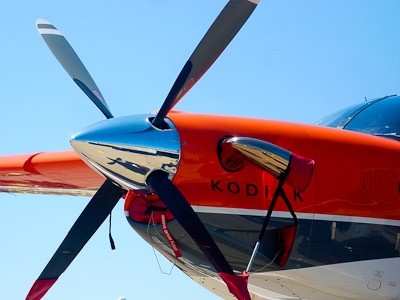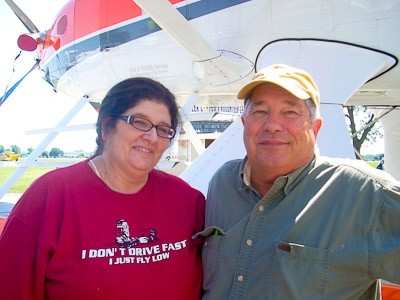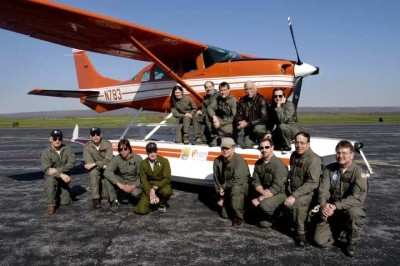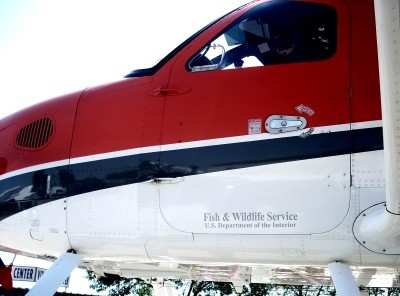Quest Kodiak Is Featured By DOI At AirVenture's Federal
Pavilion
By Maxine Scheer
The Quest Kodiak was introduced at AirVenture in 2005, and
amongst the 42 Kodiaks currently out in the field, one of them is
in service with the U.S. Department of Interior (DOI).

Visitors to EAA AirVenture's Federal Pavilion will be greeted by
a brightly painted Kodiak being used for DOI aerial surveillance
programs. Proudly sitting inside the spacious Quest Kodiak was
Pilot Fred Roetker, a pilot-biologist for over 26 years with the
department, logging 8,000+ hours flying missions for the U.S. Fish
and Wildlife service (FWS), Division of Migratory Bird
Management.
Fred provided some history on the use of aviation by FWS.
"Aviation has been a vital tool to wildlife management, especially
in remote areas," said Roetker. Just after World War II, the
availability of pilots and aircraft allowed the Fish and Wildlife
service to established its own fleet, and incorporate aviation as a
primary means of performing wildlife surveys in remote areas.

FWS Pilot Fred Roetker And Wife Janet
FWS has had the Kodiak for about 18 months, and "this aircraft",
said Fred, "represents the Next 50 Years for the Department." Fred
estimates that FWS will soon be accepting about nine Quest Kodiak's
into their fleet. He noted that FWS operates approximately 60
aircraft, approximately half of which are based in Alaska.
"The Kodiak has performed well," said Roetker. "The aircraft's
range is a key factor." In spring and summer, we fly missions as
far north as the Arctic Ocean. "It allows us to carry more people
and equipment and with the features provided by the Garmin 1000
panel, such as advanced GPS, and information on terrain, traffic
and fuel status, it significantly increases safety." Fred
speaks from experience. He estimates he has about 400+ hours in the
aircraft.
The FWS website provides some interesting aviation history on
the service. Every spring and summer for the past 50 years, teams
of FWS pilot-biologists have taken to the skies to survey North
America's waterfowl breeding grounds. Flying more than 80,000
miles, crisscrossing the country on missions that involve
low-leveling flying into areas with no weather reporting stations,
highly trained and skilled pilot-biologists fly to the some of the
most remote regions of Canada and Alaska.

Department of Fish and Wildlife Biologists With Quest
Koidak
When asked about the career opportunities with FWS, Fred's eyes lit
up. "There are openings," said Fred, "and the combination of skills
is not easy find". "We anticipate hiring 3 or four positions over
the next year for a twelve person program." He described the unique
qualities of having both a wildlife biology background and the
commercial pilot qualifications, described in more detail on USA
jobs.
This job requires a family commitment. Fred's wife Janet was
standing alongside the Kodiak and said she was happy to see her
husband. Janet noted that the nine days that comprises the FWS
visit to AirVenture represents the longest stretch of time they
have had together since May.

The next stop for Fred and the Quest Kodiak is closer to home -
the Gulf Coast, to monitor birds and injured wildlife impacted by
the BP Oil Spill. The mission of the U.S. Fish and Wildlife Service
is working with others to conserve, protect, and enhance fish,
wildlife, plants, and their habitats for the continuing benefit of
the American people.
 NTSB Prelim: Lee Aviation LLC JA30 SuperStol
NTSB Prelim: Lee Aviation LLC JA30 SuperStol Classic Aero-TV: Curtiss Jenny Build Wows AirVenture Crowds
Classic Aero-TV: Curtiss Jenny Build Wows AirVenture Crowds ANN's Daily Aero-Term (05.30.25): Very High Frequency (VHF)
ANN's Daily Aero-Term (05.30.25): Very High Frequency (VHF) Aero-News: Quote of the Day (05.30.25)
Aero-News: Quote of the Day (05.30.25) ANN's Daily Aero-Term (05.31.25): Microburst
ANN's Daily Aero-Term (05.31.25): Microburst






